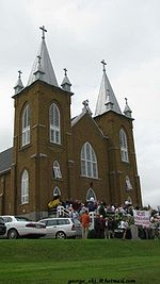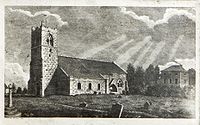
St Mary's Church, Blymhill
Encyclopedia
St. Mary's Church, Blymhill is an Anglican church in the village of Blymhill
, Staffordshire
, England . The building, which is a Grade I listed building, was constructed in the 14th century and restored and extended in the 18th and 19th centuries. It features an Early English south aisle, a Decorated Gothic chancel and a Perpendicular Gothic tower.
 There has been a church at Blymhill from an early date. Until the end of the 11th century it was attached to the collegiate church
There has been a church at Blymhill from an early date. Until the end of the 11th century it was attached to the collegiate church
of Gnosall
, which it served as a chapel of ease
. In c. 1200 a separate rectory was established at Blymhill when William, son of John Bagot, the then Lord of Blymhill, acquired the right of presentation of himself and his heirs. A full list of rectors from that date is extant.
The present church dates from the mid 14th century and it probably lies on the same site as the former chapel of ease. It is thought to have been built during the incumbency of Stephen de Bromley who was rector between 1349 and c. 1379. There is an arched recess outside the south wall of the chancel (a position often occupied by the founders tomb) containing a weathered stone coffin that is thought to be Bromley's.
The church underwent significant alterations in c. 1719 during which the Gothic windows of the nave and south aisle were replaced by large and fashionable round-headed windows. A view of the church in 1797, after these alterations, is shown on this page. The Gothic windows were re-introduced during a substantial Early English restoration
in 1858-59 by the architect George Street
along with the present vestry and new oak choir stalls, oak pews, pulpit and font. The sentences below, from the work authorization, explain the other major changes:
Street's restoration left the interior too dark so, in 1861, two new plain diamond windows were added to the south wall and in 1876 dormer
windows, rarely seen in churches, were built into the south aisle roof.
St. Chad's chapel, at the east end of the north aisle, was constructed in 1936 as a gift of the Rev. E.R.O. Bridgeman. St. Chad
is traditionally supposed to have preached in the vicinity of Blymhill in the 7th century and consecrated a well at nearby Chadwell
.
Blymhill
Blymhill is a village in Staffordshire, England....
, Staffordshire
Staffordshire
Staffordshire is a landlocked county in the West Midlands region of England. For Eurostat purposes, the county is a NUTS 3 region and is one of four counties or unitary districts that comprise the "Shropshire and Staffordshire" NUTS 2 region. Part of the National Forest lies within its borders...
, England . The building, which is a Grade I listed building, was constructed in the 14th century and restored and extended in the 18th and 19th centuries. It features an Early English south aisle, a Decorated Gothic chancel and a Perpendicular Gothic tower.
History

Collegiate church
In Christianity, a collegiate church is a church where the daily office of worship is maintained by a college of canons; a non-monastic, or "secular" community of clergy, organised as a self-governing corporate body, which may be presided over by a dean or provost...
of Gnosall
Gnosall
Gnosall is a large village in the Borough of Stafford, Staffordshire, England, with a population of approximately 5,000. It lies on the A518, approximately half-way between the towns of Newport and the county town of Staffordshire, Stafford...
, which it served as a chapel of ease
Chapel of ease
A chapel of ease is a church building other than the parish church, built within the bounds of a parish for the attendance of those who cannot reach the parish church conveniently....
. In c. 1200 a separate rectory was established at Blymhill when William, son of John Bagot, the then Lord of Blymhill, acquired the right of presentation of himself and his heirs. A full list of rectors from that date is extant.
The present church dates from the mid 14th century and it probably lies on the same site as the former chapel of ease. It is thought to have been built during the incumbency of Stephen de Bromley who was rector between 1349 and c. 1379. There is an arched recess outside the south wall of the chancel (a position often occupied by the founders tomb) containing a weathered stone coffin that is thought to be Bromley's.
The church underwent significant alterations in c. 1719 during which the Gothic windows of the nave and south aisle were replaced by large and fashionable round-headed windows. A view of the church in 1797, after these alterations, is shown on this page. The Gothic windows were re-introduced during a substantial Early English restoration
Victorian restoration
Victorian restoration is the term commonly used to refer to the widespread and extensive refurbishment and rebuilding of Church of England churches and cathedrals that took place in England and Wales during the 19th-century reign of Queen Victoria...
in 1858-59 by the architect George Street
George Edmund Street
George Edmund Street was an English architect, born at Woodford in Essex.- Life :Street was the third son of Thomas Street, solicitor, by his second wife, Mary Anne Millington. George went to school at Mitcham in about 1830, and later to the Camberwell collegiate school, which he left in 1839...
along with the present vestry and new oak choir stalls, oak pews, pulpit and font. The sentences below, from the work authorization, explain the other major changes:
George Thomas Orlando Bridgeman Clerk Rector ... are authorised and empowered to take down the gallery on the West side (Tower end) and the wall on the north side of the said Church, to widen and extend the same on the North side, to make an aisle on the same side, to stop up the present entrance (through the Tower) and to erect a Porch on the North side, and to erect new roofs over the whole Church.
Street's restoration left the interior too dark so, in 1861, two new plain diamond windows were added to the south wall and in 1876 dormer
Dormer
A dormer is a structural element of a building that protrudes from the plane of a sloping roof surface. Dormers are used, either in original construction or as later additions, to create usable space in the roof of a building by adding headroom and usually also by enabling addition of windows.Often...
windows, rarely seen in churches, were built into the south aisle roof.
St. Chad's chapel, at the east end of the north aisle, was constructed in 1936 as a gift of the Rev. E.R.O. Bridgeman. St. Chad
Chad of Mercia
Chad was a prominent 7th century Anglo-Saxon churchman, who became abbot of several monasteries, Bishop of the Northumbrians and subsequently Bishop of the Mercians and Lindsey People. He was later canonized as a saint. He was the brother of Cedd, also a saint...
is traditionally supposed to have preached in the vicinity of Blymhill in the 7th century and consecrated a well at nearby Chadwell
Chadwell, Shropshire
Chadwell is a hamlet in the county of Shropshire, England. It lies 1/2 mile west of the village of Great Chatwell over the Staffordshire border and comprises a number of red brick buildings including a converted water mill. The name derives either from the Old English for 'the cold spring' or from...
.
Notable incumbents
Dates of incumbency are in parentheses.- Samuel DickensonSamuel DickensonSamuel Dickenson was a clergyman and botanist.He was educated at St John's College, Cambridge, where he was a contemporary of Erasmus Darwin. He succeeded his father John Dickenson as Rector of St...
(January 9, 1777 – May 15, 1823) – botanist - George Thomas Orlando BridgemanGeorge Thomas Orlando BridgemanGeorge Thomas Orlando Bridgeman was a clergyman and antiquary, the second son of George Bridgeman, 2nd Earl of Bradford....
(November 12, 1853 – 1865) – antiquary

